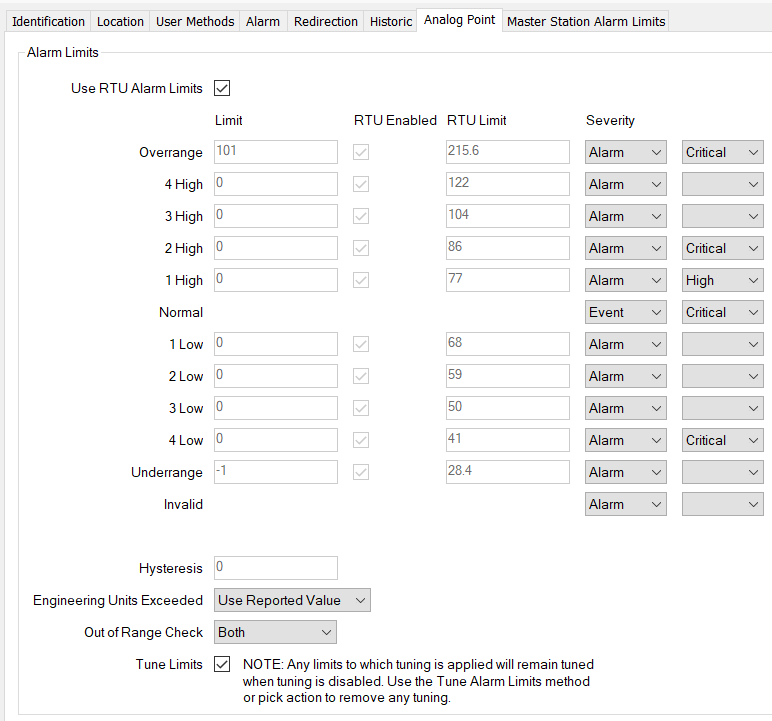Alarm Limits
Use the fields within the Alarm Limits section of the Analog Point tab to specify the properties that are associated with a SCADAPack x70 Analog point's limits.

The Use RTU Alarm Limits check box enables you to define whether the SCADAPack x70 protocol-specific analog point uses the alarm limits that are inherited from the associated SCADAPack x70 Analog Configuration item. These are the same limits that the RTU (SCADAPack x70 device) uses to generate events. This check box is enabled by default.
If you clear this check box, the Limit column is enabled and you can define alarm limits that are independent of the alarm limits that are configured in the RTU. The Hysteresis field is also enabled.
The analog point inherits its RTU Enabled settings and RTU Limit values from the SCADAPack x70 Analog Configuration item with which it is associated (see Configure the SCADAPack x70 Device's Alarm Limits Settings, and see Configure the Out Of Range Limits).(If you have not re-opened this configuration Form since using the Form's SCADAPack x70 Object field to associate this Point with the relevant Configuration item, you may need to refresh the Form in order for these fields to display their inherited values. Likewise, if the inherited values are changed on that Configuration item's Form while this Point Form remains open, you might also need to refresh this Form to display the updated inherited values. To do this, save the configuration changes.) The RTU Enabled column indicates which alarm limits are enabled on the associated Configuration item. If you are using the RTU's alarm limits and if an alarm limit is not enabled on the Configuration item, the associated fields are grayed out. An alarm limit is only enabled when the associated RTU Event on the Configuration item is set to an option other than 'Disabled' (see Configure the SCADAPack x70 Device's Alarm Limits Settings).
The RTU Limit values that are shown in the Alarm Limits section are specified in engineering unit (floating point) values. The values take into account any Master Station Scaling (see Specify the Scaling Applied by Geo SCADA Expert). Geo SCADA Expert applies the defined Multiplier and Offset to the Limit values from the Configuration item and then displays the resulting values in the RTU Limits column on the analog point's Analog Point tab. If need be, you can see how these values correspond to the point's raw values by scrolling to the Scaling and SCADAPack Scaling sections of this tab. Again, these values are inherited from the SCADAPack x70 Analog Configuration item with which the analog point is associated (see Specify the SCADAPack x70 Device's Point Scaling).
The other alarm limit fields are common to various types of analog point. For more information, see Configure the Limits for an Analog Point in the Geo SCADA Expert Guide to Core Point Configuration.
For information about the properties that appear towards the bottom of the Alarm Limits section, select the relevant links below:
- Hysteresis—Use to Specify the Hysteresis - the Minimum Value Change that can Clear an Alarm.
This field is enabled only when the analog point uses local alarm limits and is disabled if the analog point inherits its alarm limits from the associated Configuration item. If the analog point is using RTU alarm limits, the Alert Clear Value Deadband field is used and inherits the value from the RTU.
- Engineering Units Exceeded—Use to Define how Over Range and Under Range Values are Processed.
- Out of Range Check—Use to Specify how the Driver Determines whether a Reported Value is Out of Range.
- Tune Limits—Use to Define whether an Analog Point’s Limits can be Tuned.
The Tuning implementation differs slightly in this driver compared to other drivers (see Tune Limits).
- Area of Interest—This field is only displayed if the Area of Interest feature is enabled on your system. Use the field to specify the Area of Interest with which any state-related point alarms or events are to be associated (see Specify the Area of Interest Associated with a Point’s State-Related Alarms and Events).